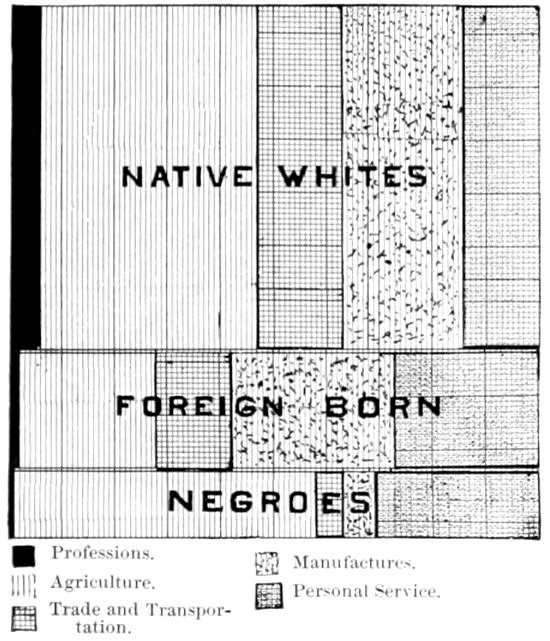
Proportion of the Population and its elements, which were engaged in gainful occupations in 1890.
Diagram No. 1.
Transcriber’s Note:
The cover image was created by the transcriber and is placed in the public domain.
| Appointed. | ||
|---|---|---|
| 1882. | Rutherford B. Hayes, of Ohio. | [1]1893. |
| 1882. | Morrison R. Waite, of the District of Columbia. | [1]1888. |
| 1882. | William E. Dodge, of New York. | [1]1883. |
| 1882. | Phillips Brooks, of Massachusetts. | [2]1889. |
| 1882. | Daniel C. Gilman, of Maryland. | |
| 1882. | John A. Stewart, of New York. | |
| 1882. | Alfred H. Colquitt, of Georgia. | [1]1894. |
| 1882. | Morris K. Jesup, of New York. | |
| 1882. | James P. Boyce, of Kentucky. | [1]1888. |
| 1882. | William A. Slater, of Connecticut. | |
| Elected. | ||
| 1883. | William E. Dodge, Jr., of New York. | |
| 1888. | Melville W. Fuller, of the District of Columbia. | |
| 1889. | John A. Broadus, of Kentucky. | [1]1895. |
| 1889. | Henry C. Potter, of New York. | |
| 1891. | J. L. M. Curry, of the District of Columbia. | |
| 1894. | William J. Northen, of Georgia. | |
| 1894. | Ellison Capers, of South Carolina. | [2]1895. |
| 1894. | C. B. Galloway, of Mississippi. | |
| 1895. | Alexander E. Orr, of New York. | |
1. Died in office.
2. Resigned.
From 1882 to 1891, the General Agent of the Trust was Rev. A. G. Haygood, D. D., of Georgia, who resigned the office when he became a Bishop of the Methodist Episcopal Church, South. Since 1891, the duties of a General Agent have been discharged by Dr. J. L. M. Curry, of Washington, D. C., Chairman of the Educational Committee.
The Trustees of the John F. Slater Fund propose to publish from time to time papers that relate to the education of the colored race. These papers are designed to furnish information to those who are concerned in the administration of schools, and also to those who by their official stations are called upon to act or to advise in respect to the care of such institutions.
The Trustees believe that the experimental period in the education of the blacks is drawing to a close. Certain principles that were doubted thirty years ago now appear to be generally recognized as sound. In the next thirty years better systems will undoubtedly prevail, and the aid of the separate States is likely to be more and more freely bestowed. There will also be abundant room for continued generosity on the part of individuals and associations. It is to encourage and assist the workers and the thinkers that these papers will be published.
Each paper, excepting the first number (made up chiefly of official documents), will be the utterance of the writer whose name is attached to it, the Trustees disclaiming in advance all responsibility for the statement of facts and opinions.
The statistics of occupations used in this paper are from the Census of 1890, and represent the status of the race on June 1 of that year. The Census takes cognizance only of “gainful” occupations, excluding from its lists housewives, school children, men of leisure, etc. Its schedules deal only with wage-earners, those directly engaged in earning their living.
In 1890, out of a total population of 62,622,250, 22,753,884 persons, or 34.6 per cent., were engaged in gainful occupations. Of the negroes, including all of mixed negro blood, numbering 7,470,040, 3,073,123, or 41.1 per cent., were engaged in gainful occupations. The proportion was much greater than with the total population. This total population, however, was composed of several diverse elements, including, besides the negroes themselves, the foreign born (of which a large proportion were adult males), and the native whites. The following table presents the proportions of each of these elements which were engaged in gainful occupations:
| Proportion. | Per Cent. |
|---|---|
| Total population | 34.6 |
| Whites | 35.5 |
| Native whites | 31.6 |
| Foreign born | 55.2 |
| Negroes | 41.1 |
6The diagram No. 1 sets forth these figures in graphic form. The total area of the square represents the population. This is sub-divided by horizontal lines into rectangles representing the various elements of the population, and the shaded part of each rectangle represents the proportions engaged in gainful occupations.
The proportion was greatest among the foreign born because of the large proportion of adults, and particularly of males, among this element. Next to that, the proportion was greatest among the negroes, being much greater than among the whites collectively and still greater than among the native whites.
Classifying the wage-earners of the country in respect to race and nativity, it appears that 64.5 per cent. were native whites, 22 per cent. were of foreign birth, and 13.5 per cent. were negroes.
Analyzing the statistics of occupation by sex, it is discovered that the proportion of native white males who had occupations was 53.4 and of females 9.4 per cent. The corresponding proportion of male negroes was 56.3 per cent. and of female negroes 26.0 per cent. The male negroes were slightly more fully occupied than were the native whites, while among females the proportion of wage-earners was much greater. The difference between native whites and negroes in the proportion of wage-earners was, therefore, due mainly to the fuller occupation of women. To put it in another form: Out of every hundred native whites who pursued gainful occupations, 85 were males and 15 were females. Of every hundred negroes, 69 were males and 31 were females. Indeed, a larger proportion of women pursued gainful occupations among negroes than in any other class of the population.
The primary classification of occupations made by the Census recognized five great groups, as follows: 1. Professions; 2. Agriculture; 3. Trade and transportation; 4. Manufactures; 5. Personal Service. These titles are self-explanatory, with the possible exception of the last class, which is mainly composed of domestic servants.

Proportion of the Population and its elements, which were engaged in gainful occupations in 1890.
Diagram No. 1.
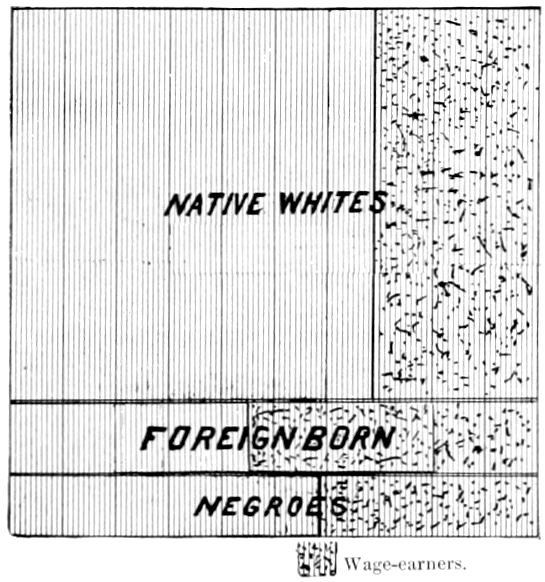
Classification of the Wage-earners by Race and Nativity and by Occupations.
Diagram No. 2.
7The following table shows the proportion of the negro wage-earners engaged in each of these groups of occupations. In juxtaposition, for comparison, are placed similar figures for the native whites and the foreign born.
| Native White. | Foreign Born. | Negro. | |
|---|---|---|---|
| Per Cent. | Per Cent. | Per Cent. | |
| Professions | 5.5 | 2.2 | 1.1 |
| Agriculture | 41.0 | 25.5 | 57.2 |
| Trade and transportation | 17.0 | 14.0 | 4.7 |
| Manufactures | 22.9 | 31.3 | 5.6 |
| Personal service | 13.6 | 27.0 | 31.4 |
| 100.0 | 100.0 | 100.0 |
Similar facts are shown by diagram No. 2. In this the total area of the square represents the number of persons in the country pursuing gainful occupations. This is divided into rectangles by horizontal lines, the rectangles being proportioned respectively to the numbers of the native whites, the foreign born, and the negroes. The sub-division of these rectangles by vertical lines indicates the proportion in each group of wage-earners.
The most striking facts brought out by this table and diagram are that only a trifling proportion of the negroes were in the professions, that much more than one-half were farmers, and nearly one-third were engaged in personal (mainly domestic) service. Indeed, over seven-eighths of them were either farmers or servants. The proportions engaged in trade and transportation and in manufactures were very small. In respect to the farming class, they contrasted sharply with the foreign born. In trade and transportation and in manufactures the contrast was even greater, in the contrary direction. The foreign born contained a much larger proportion of professional men.
Comparing the negroes with the native whites, equally interesting contrasts appear. Professional men were much 8more numerous among whites than among negroes. The proportion of the farming class, although much smaller, was nearer that of the negroes than was the same class among the foreign born. In trade and transportation and in manufactures the native whites had much greater proportions, while in personal service the proportion was much less than that of the negroes.
It will be interesting to analyze these figures further. The following table classifies negro wage-earners by occupation and by sex, giving for each sex the percentage engaged in each group of occupations:
| Male. | Female. | |
|---|---|---|
| Professions | 1.2 | 0.9 |
| Agriculture | 63.4 | 44.0 |
| Trade and transportation | 6.8 | 0.2 |
| Manufactures | 7.0 | 2.8 |
| Personal service | 21.6 | 52.1 |
These figures are also illustrated by diagram No. 3, the area of which represents all negro wage-earners. The two rectangles into which it is divided represent the males and females; each of these is sub-divided into rectangles representing the number in each group of occupations. Of the male negro wage-earners, more than three-fifths were farmers and a little less than one-fourth were servants. The two classes jointly accounted for nearly 85 per cent. of all.
Of the females, considerably less than one-half were farmers and more than one-half were servants—the two classes together accounting for 95 per cent. of all. This large proportion of female negro farmers was doubtless made up in the main of women and female children employed in the cotton fields.
The following table, abstracted from the Census publications, shows the number of negroes in all occupations and in each of the five great groups of occupations by sex and by states and territories:
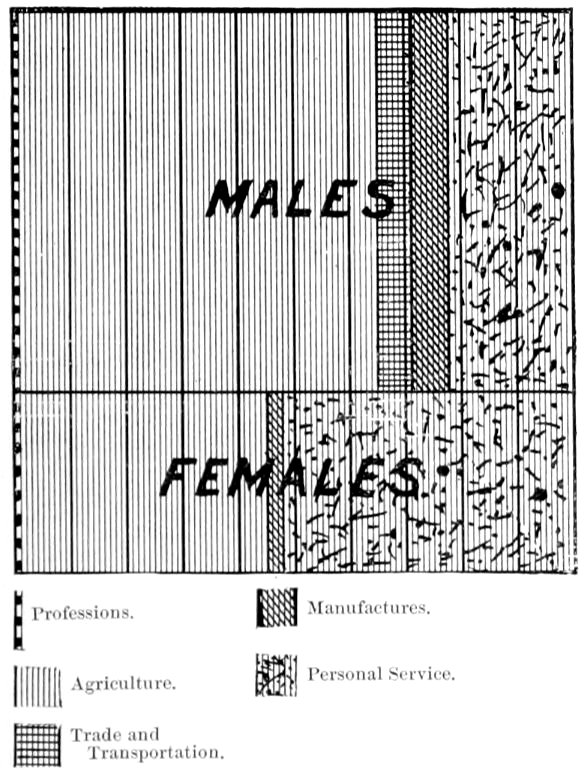
Classification of Negro Wage-earners by Sex and Occupation.
Diagram No. 3.
| Negroes. | |||||||||||||
| All Occupations. | Agriculture, Fisheries, and Mining. | Professional Service. | Domestic and Personal Service. | Trade and Transportation. | Manufacturing and Mechanical Industries. | ||||||||
|---|---|---|---|---|---|---|---|---|---|---|---|---|---|
| Males. | Females. | Males. | Females. | Males. | Females. | Males. | Females. | Males. | Females. | Males. | Females. | ||
| The United States. | 2,101,233 | 971,890 | 1,329,584 | 427,835 | 25,171 | 8,829 | 457,002 | 505,898 | 143,350 | 2,399 | 146,126 | 26,929 | |
| 1. | Alabama | 192,322 | 101,085 | 146,361 | 66,123 | 1,471 | 491 | 25,426 | 33,380 | 9,147 | 140 | 9,917 | 951 |
| 2. | Alaska | ||||||||||||
| 3. | Arizona | 1,091 | 71 | 29 | 3 | 1,034 | 67 | 13 | 12 | 4 | |||
| 4. | Arkansas | 86,861 | 30,115 | 68,219 | 19,069 | 1,226 | 238 | 11,226 | 10,506 | 2,787 | 27 | 3,403 | 275 |
| 5. | California | 4,301 | 1,041 | 1,084 | 14 | 86 | 21 | 2,316 | 897 | 457 | 3 | 358 | 106 |
| 6. | Colorado | 2,765 | 792 | 180 | 4 | 75 | 13 | 1,702 | 715 | 406 | 5 | 402 | 55 |
| 7. | Connecticut | 4,064 | 1,964 | 879 | 1 | 61 | 10 | 1,925 | 1,781 | 634 | 7 | 565 | 165 |
| 8. | Delaware | 9,334 | 3,016 | 4,157 | 34 | 97 | 32 | 3,631 | 2,878 | 633 | 21 | 816 | 51 |
| 9. | Dist. of Columbia | 21,238 | 18,770 | 553 | 16 | 390 | 335 | 12,680 | 16,734 | 4,776 | 195 | 2,839 | 1,490 |
| 10. | Florida | 46,302 | 19,071 | 23,690 | 7,629 | 776 | 223 | 13,229 | 10,421 | 4,106 | 52 | 4,501 | 746 |
| 11. | Georgia | 246,913 | 122,352 | 172,496 | 54,073 | 2,122 | 958 | 39,294 | 65,025 | 16,397 | 372 | 16,604 | 1,924 |
| 12. | Idaho | 83 | 23 | 16 | 1 | 57 | 21 | 8 | 2 | 1 | |||
| 13. | Illinois | 19,270 | 4,713 | 4,323 | 134 | 486 | 116 | 10,865 | 4,061 | 1,994 | 41 | 1,602 | 361 |
| 14. | Indiana | 14,648 | 4,210 | 3,273 | 37 | 330 | 126 | 7,950 | 3,849 | 1,426 | 23 | 1,669 | 175 |
| 15. | Iowa | 3,615 | 730 | 973 | 11 | 78 | 11 | 1,966 | 672 | 289 | 1 | 309 | 35 |
| 16. | Kansas | 13,889 | 3,400 | 4,171 | 110 | 357 | 69 | 6,898 | 3,077 | 1,148 | 20 | 1,315 | 124 |
| 17. | Kentucky | 76,411 | 31,255 | 38,456 | 1,013 | 1,406 | 420 | 22,649 | 28,916 | 7,381 | 66 | 6,519 | 840 |
| 18. | Louisiana | 159,180 | 83,978 | 111,820 | 49,428 | 1,251 | 355 | 31,609 | 31,292 | 6,045 | 129 | 8,455 | 2,774 |
| 19. | Maine | 409 | 145 | 104 | 2 | 8 | 2 | 174 | 128 | 68 | 2 | 55 | 11 |
| 20. | Maryland | 63,166 | 32,642 | 29,516 | 743 | 640 | 275 | 21,014 | 30,406 | 7,538 | 144 | 4,458 | 1,074 |
| 21. | Massachusetts | 7,593 | 3,435 | 601 | 4 | 162 | 57 | 4,296 | 2,914 | 1,402 | 34 | 1,132 | 426 |
| 22. | Michigan | 5,065 | 1,329 | 1,458 | 45 | 115 | 39 | 2,495 | 1,102 | 448 | 6 | 549 | 137 |
| 23. | Minnesota | 1,719 | 383 | 72 | 2 | 57 | 13 | 1,286 | 315 | 216 | 5 | 88 | 48 |
| 24. | Mississippi | 198,531 | 105,306 | 167,995 | 77,925 | 1,970 | 775 | 17,209 | 25,729 | 5,671 | 74 | 5,686 | 803 |
| 25. | Missouri | 43,940 | 16,715 | 15,757 | 324 | 897 | 337 | 18,899 | 15,614 | 4,862 | 44 | 3,525 | 396 |
| 1026. | Montana | 971 | 140 | 41 | 25 | 4 | 815 | 122 | 45 | 1 | 45 | 13 | |
| 27. | Nebraska | 3,741 | 959 | 242 | 3 | 63 | 7 | 2,743 | 881 | 323 | 4 | 370 | 64 |
| 28. | Nevada | 130 | 22 | 41 | 1 | 67 | 18 | 17 | 1 | 5 | 2 | ||
| 29. | New Hampshire | 242 | 107 | 60 | 5 | 81 | 84 | 24 | 72 | 23 | |||
| 30. | New Jersey | 16,143 | 7,738 | 4,166 | 29 | 287 | 82 | 7,715 | 7,339 | 2,111 | 25 | 1,864 | 263 |
| 31. | New Mexico | 888 | 156 | 163 | 3 | 10 | 651 | 150 | 40 | 24 | 3 | ||
| 32. | New York | 23,272 | 13,664 | 3,031 | 25 | 571 | 135 | 13,151 | 12,445 | 4,231 | 54 | 2,288 | 1,005 |
| 33. | North Carolina | 148,370 | 68,220 | 106,493 | 33,796 | 1,619 | 565 | 20,580 | 31,393 | 7,564 | 106 | 12,114 | 2,360 |
| 34. | North Dakota | 146 | 23 | 35 | 7 | 90 | 22 | 10 | 4 | 1 | |||
| 35. | Ohio | 28,085 | 7,791 | 6,201 | 108 | 617 | 246 | 14,814 | 6,955 | 3,027 | 40 | 3,426 | 442 |
| 36. | Oklahoma | 958 | 125 | 635 | 17 | 22 | 3 | 231 | 102 | 28 | 1 | 42 | 2 |
| 37. | Oregon | 536 | 99 | 106 | 2 | 23 | 5 | 328 | 81 | 42 | 1 | 37 | 10 |
| 38. | Pennsylvania | 37,534 | 15,704 | 4,602 | 29 | 584 | 197 | 22,505 | 14,297 | 5,213 | 104 | 4,630 | 1,077 |
| 39. | Rhode Island | 2,337 | 1,362 | 270 | 2 | 38 | 18 | 1,161 | 1,169 | 546 | 3 | 322 | 170 |
| 40. | South Carolina | 186,714 | 102,836 | 149,915 | 73,588 | 1,543 | 506 | 18,554 | 26,213 | 6,860 | 188 | 9,842 | 2,341 |
| 41. | South Dakota | 284 | 43 | 33 | 1 | 1 | 2 | 115 | 35 | 121 | 1 | 14 | 4 |
| 42. | Tennessee | 121,016 | 44,701 | 72,316 | 12,510 | 1,736 | 592 | 25,606 | 30,333 | 10,954 | 125 | 10,404 | 1,141 |
| 43. | Texas | 123,395 | 46,691 | 85,824 | 20,758 | 2,031 | 563 | 23,360 | 24,840 | 6,386 | 69 | 5,794 | 461 |
| 44. | Utah | 298 | 51 | 21 | 1 | 248 | 48 | 14 | 1 | 14 | 2 | ||
| 45. | Vermont | 322 | 109 | 112 | 1 | 3 | 143 | 102 | 33 | 31 | 6 | ||
| 46. | Virginia | 169,343 | 71,752 | 93,745 | 10,164 | 1,654 | 911 | 39,425 | 55,941 | 15,655 | 253 | 18,864 | 4,483 |
| 47. | Washington | 902 | 153 | 250 | 2 | 16 | 2 | 480 | 134 | 69 | 87 | 15 | |
| 48. | West Virginia | 11,478 | 2,623 | 4,790 | 50 | 166 | 63 | 3,515 | 2,462 | 2,080 | 7 | 927 | 41 |
| 49. | Wisconsin | 855 | 205 | 168 | 4 | 27 | 11 | 481 | 161 | 74 | 1 | 105 | 28 |
| 50. | Wyoming | 563 | 75 | 141 | 58 | 1 | 313 | 71 | 31 | 3 | 20 | ||
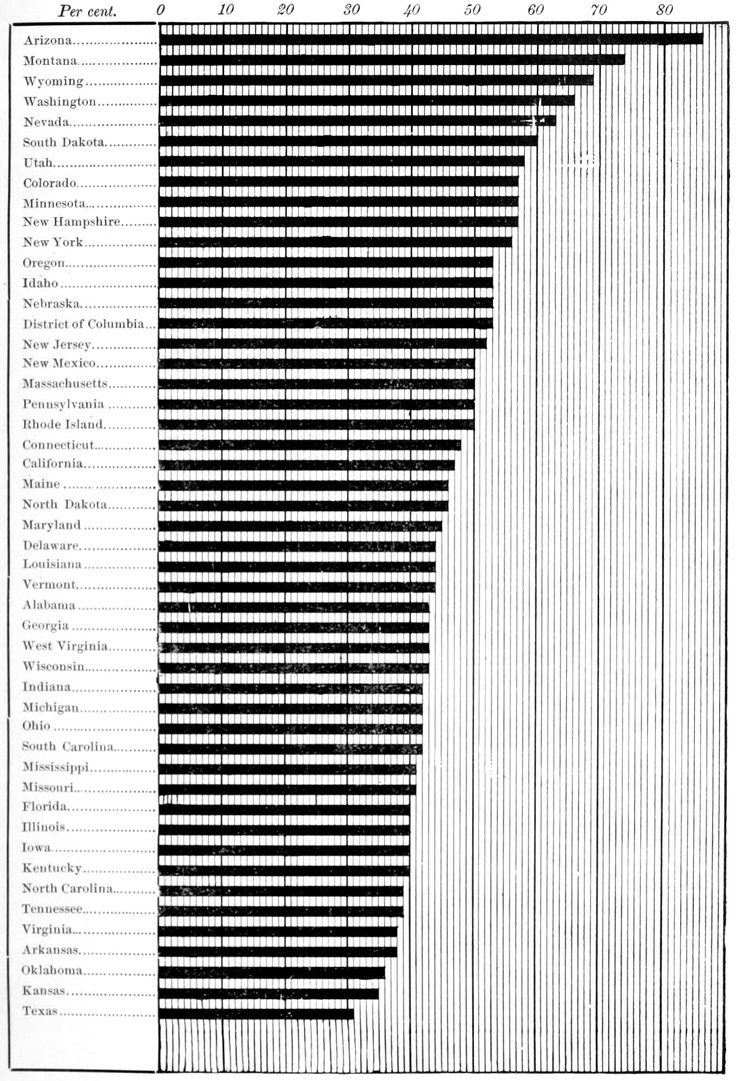
Proportion of Negro Wage-earners to Negro Population.
Diagram No. 4.
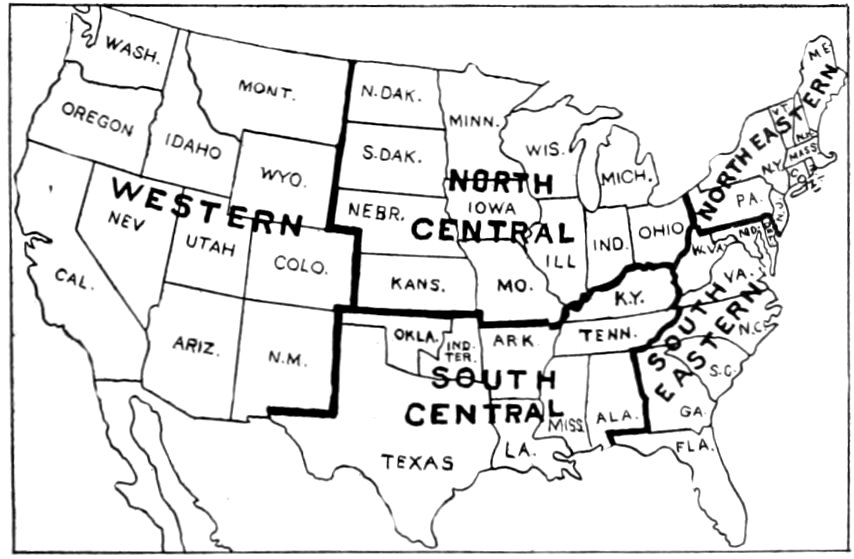
Grouping of the States and Territories.
Diagram No. 5.
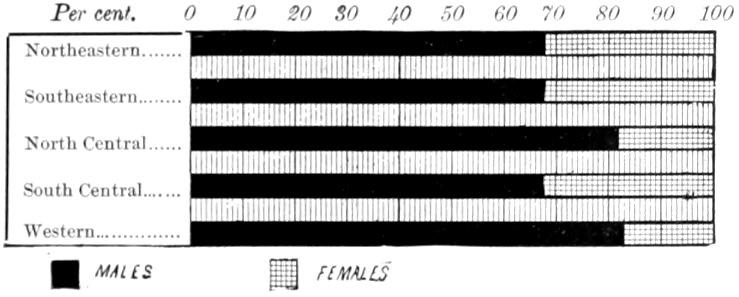
Proportions of Male and Female Wage-earners.
Diagram No. 6.
The foregoing diagram No. 4 shows by the length of the bars the proportion which the negro wage-earners bore in 1890 to the negro population of each state. This proportion was greatest in the states and the territories of the west. Following these are the northeastern states, while the lower part of the column is made up of the states in the upper Mississippi valley and those of the south.
The distribution of wage-earners among the five occupation groups differed widely in different parts of the country. To study it, it will be sufficient to group the states and analyze the statistics of each group.
The groups which will be used here are those which have been in use in the last two censuses—namely, the northeastern and southeastern, north central and south central, and western groups. The states and territories of which each group is composed are shown in map No. 5.
Examination of the states forming the above groups will show that the groups are in many respects very characteristic. The southeastern and south central groups contain nine-tenths of the negroes of the country. These states may be said to constitute the home of the negro, while in the northern and western states he is an immigrant.
Diagram No. 6 shows the distribution by sex and by groups of states of the negro wage-earners. It appears that in the northeastern, southeastern, and south central groups two-thirds of the wage-earners were males and one-third were females, while in the north central and western groups about five-sixths were males and one-sixth only were females. This is in part due to the disproportionate number of males in these parts of the country.
12Diagram No. 7 shows the distribution of the negro wage-earners, classified by sex, among the five occupation groups and by groups of states. The length of each bar represents 100 per cent., and each bar is divided proportionately among the different occupation groups. Thus from it we read that in the northeastern states 15 per cent. of the male wage-earners were engaged in agriculture, 56 per cent. in personal service, 16 per cent. in trade and transportation, 12 per cent. in manufactures, and 2 per cent. in the professions.
It is seen that a far larger proportion of male wage-earners were engaged in agriculture in the southern states than in the northern and western states, the proportion in the two groups of the former states being 64 and 71 per cent., while in the northeastern states only 15 per cent. were engaged in agriculture, in the north central states 26 per cent., and in the western states 17 per cent.
In trade and transportation the highest proportion was found in the northeastern states, where it was 16 per cent.; in the north central states it was 14 and in the western states 10 per cent., while in the southeastern states it was 7 per cent. and in the south central states 7 per cent.
Of course, the magnitude of the proportion in the northeastern states is due to the fact that this is the commercial and manufacturing section of the country, where a large proportion of all the population is engaged in these avocations. The same is the case, though in less degree, in the north central states, while the southern states are almost purely agricultural. The figures relating to manufacturing occupations show similar characteristics. It will be noted that in the northern and western states the occupations of the negroes were more diversified than in the southern states. Agriculture and personal service in the northeastern states occupied but 71 per cent. of all wage-earners, in the north central states they occupied 75 per cent., and in the western states 81 per cent., while in the southeastern states these two occupation groups comprised 84 per cent. and in the south central 88 per cent. of all.
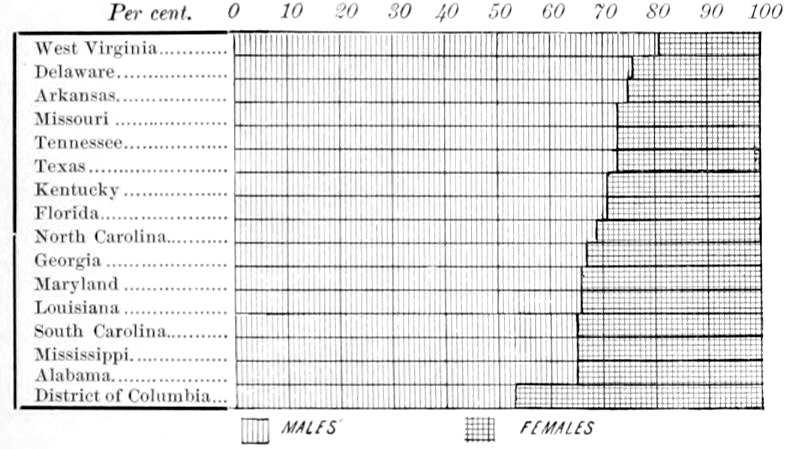
Distribution of Occupations by Sex and Sections of the Country.
Diagram No. 7.
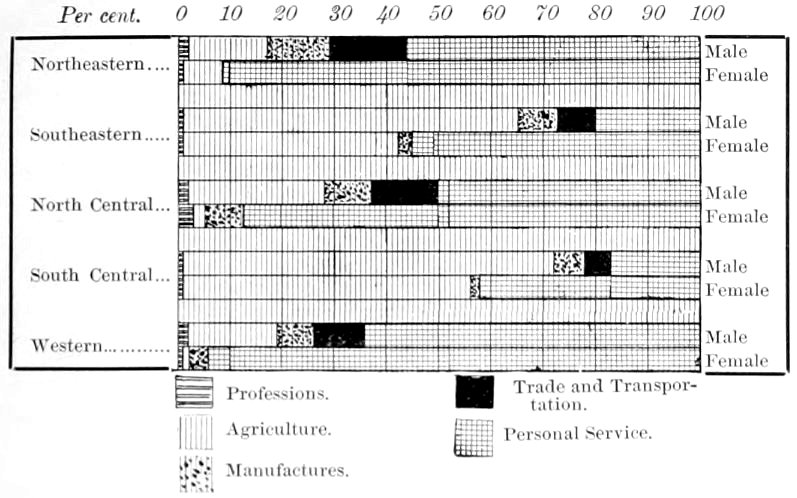
Proportions of Males and Females among the Negro Wage-earners.
Diagram No. 8.
13The diagram shows in a similar manner the distribution of the female negro wage-earners. There were engaged in agriculture in the northern and western states but a trifling proportion of negro women, while in the southern states as a whole nearly one-half of the female negro wage-earners were engaged in that avocation. On the other hand, personal service occupied fully nine-tenths of the female wage-earners in the northern and western states, while in the southern states less than one-half were engaged in it. Indeed, 94 per cent. of the female wage-earners of the west were engaged in personal service, 91 per cent. in the northeastern states, and 87 per cent. in the north central states. In trade and transportation the proportion was trifling, and in manufactures it was small, although much larger in the north and west than in the south.
Here, also, we see that agriculture and personal service occupied nearly all wage-earners—91 per cent. in the northeastern states, 96 per cent. in the southeastern states, 89 per cent. in the north central states, 97 per cent. in the south central states, and 95 per cent. in the western states. Occupations were slightly more diversified in the north and west than in the southern states, as was the case with the males.
It will now be of interest to extend this study in detail by states, but, in doing so, the study will be confined to the southern, the former slave states, which are, in a sense, the home of the negro, and in which more than nine-tenths of them live. In most of the northern states the number of negroes is so small that any conclusions drawn from statistics regarding them are worthless and are likely to be misleading.
Diagram No. 8 shows the distribution by sex of the negro wage-earners of these southern states. The total length of the bar represents in each case all the wage-earners, the white portion representing the males and the shaded portion the females.
14This diagram shows that the greatest proportion of female wage-earners is in the District of Columbia, where it is nearly one-half of all negro wage-earners, and the least in West Virginia, where it is less than one-fifth of all. In most of the cotton states it ranges from one-fourth to one-third of all negro wage-earners.
Diagrams Nos. 9 and 10 present the proportion of male and of female negro wage-earners who are engaged in agriculture, personal service, and other occupations in the southern states.
The first of these diagrams, representing male wage-earners, shows that agriculture and personal service accounted for from 63 to 94 per cent. of all male wage-earners. Indeed, excluding the District of Columbia from consideration, from 73 to 93 per cent. were accounted for by these two occupations.
Again excluding the District of Columbia, which is not a farming community, the male wage-earners who were farmers constituted in the different states proportions varying from 36 per cent. in Missouri to 85 per cent. in Mississippi. The proportion of farmers was highest in the cotton states and decidedly less in the border states. On the other hand, the proportion of males engaged in personal service was least in the cotton states and increased decidedly in those further north.
The second diagram, illustrating the occupations of female wage-earners, has certain features in common with that relating to males, but these features are more accented. In the cotton states a large proportion of the female wage-earners worked in the fields, and was therefore reported as engaged in agriculture, while in the border states but a small proportion was found there. On the other hand, domestic service claimed nearly all female wage-earners in the border states, but in the cotton states a relatively small proportion.
Both the diagrams, and especially the first, show an important feature. In the cotton states wage-earners were almost entirely either farmers or those engaged in personal service, but in the states farther north these classes were relatively smaller and occupations were somewhat more varied.
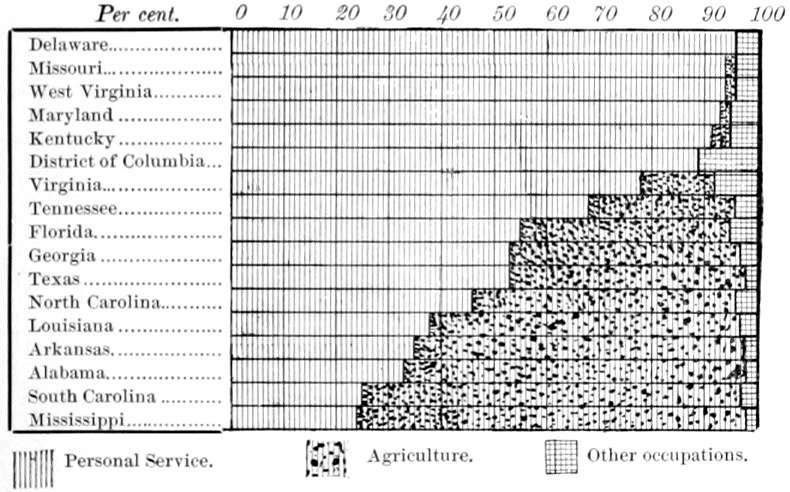
Proportions of Male Negro Wage-earners engaged in Agriculture, Personal Service and other occupations.
Diagram No. 9.
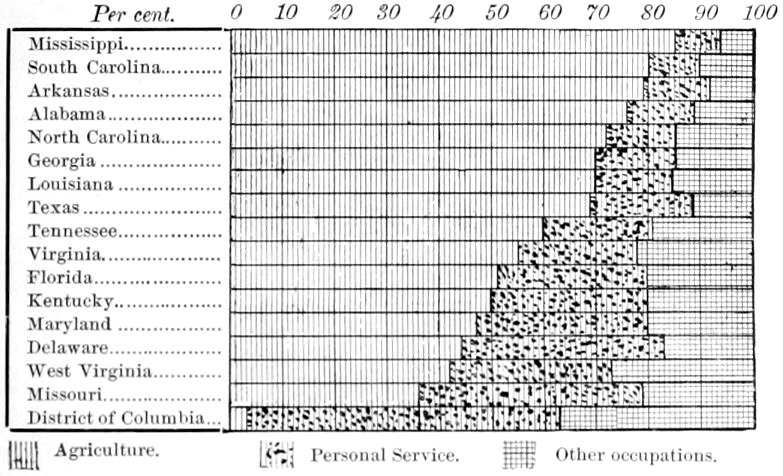
Proportions of Female Negro Wage-earners engaged in Personal Service, Agriculture, and other Occupations.
Diagram No. 10.
The statistics of farm and home ownership and of mortgage indebtedness of the Eleventh Census throw some light upon the pecuniary condition of the negro race.
The total number of farms and homes in the country in 1890 was 12,690,152, of which the negroes occupied 1,410,769, or 11.1 per cent. The proportion of negroes to the total population was at that time 12.20 per cent., showing a deficiency in the proportion occupying homes and farms when compared with the population.
The number of farms in the country was 4,767,179. Of these, 549,642, or 11.5 per cent., were occupied by negroes, being a proportion greater than that of farms and homes combined.
The number of homes, as distinguished from farms, in the country was 7,922,973, of which 861,137, or 10.9 per cent., were occupied by negroes, being a proportion less than that of farms and homes combined.
Of the 549,632 farms in the country occupied by negroes, 120,738, or 22.0 per cent., were owned by their occupants. The corresponding proportion for whites was 71.7 per cent. Of course, as regards tenants, the reverse was the case, the proportions being for whites 28.3 per cent, and for negroes 78.0 per cent. More than three-fourths of the farms occupied by negroes were rented; in other words, more than three-fourths of the negro farmers were tenants, while less than one-fourth of the white farmers were tenants.
Of the farms owned by the negroes, 90.4 per cent. were without incumbrance. Of those owned by whites, 71.3 were without incumbrance, showing a much larger proportion encumbered than among those owned by negroes.
Of 861,137 homes occupied by negroes in 1890, 143,550 were owned by their occupants and 717,587 were rented, the proportions being 19.0 per cent. and 81.0 per cent. Corresponding proportions for whites were 39.4 per cent. and 60.6 per cent. Of the houses owned by negro occupants, 126,264, or 87.7 per cent., were free and 12.3 encumbered. Corresponding 16figures for whites were 71.3 and 28.7 per cent., showing, as before, a much greater proportion of free holdings among negroes than among whites.
Diagrams Nos. 11 and 12 summarize the above facts in graphic form. The total areas of the squares represent the number of farms and homes respectively, those occupied by whites and negroes respectively being represented by the rectangles into which the squares are divided by horizontal lines. The vertical lines sub-divide these rectangles into others proportional to the numbers occupied by owners without and with incumbrance, and by renters.
The male negroes occupied in agriculture numbered, in 1890, 1,329,584. Of these, 510,619 occupied farms, the remainder, 818,965, being presumably farm laborers. The negro farmers, i. e., occupants of farms, constituted 38.3 per cent. of the male negroes engaged in agriculture, leaving 61.7 per cent. of the number as laborers. The corresponding figures for whites were 60.4 per cent. and 39.6 per cent. The proportion of negroes engaged in agriculture who were farmers—i. e., occupied farms—was, therefore, much smaller than that of the whites. In spite of this low comparative showing, however, it must be agreed that, considering all the attendant circumstances, the proportion of negro farm occupants—more than one-third of all negroes engaged in agriculture—is unexpectedly large.
Summing up the salient points in this paper, it is seen that in the matter of occupations the negro is mainly engaged either in agriculture or personal service. He has, in a generation, made little progress in manufactures, transportation, or trade. In these two groups of occupations, males are in greater proportion engaged in agriculture and females in domestic service. They have, however, during this generation, made good progress toward acquiring property, especially in the form of homes and farms, and, in just so far as they have acquired possession of real estate, it is safe to say that they have become more valuable as citizens. The outlook for them is very favorable as agriculturists, but there is little prospect that the race will become an important factor in manufactures, transportation, or commerce.

FARMS.
Diagram No. 11.
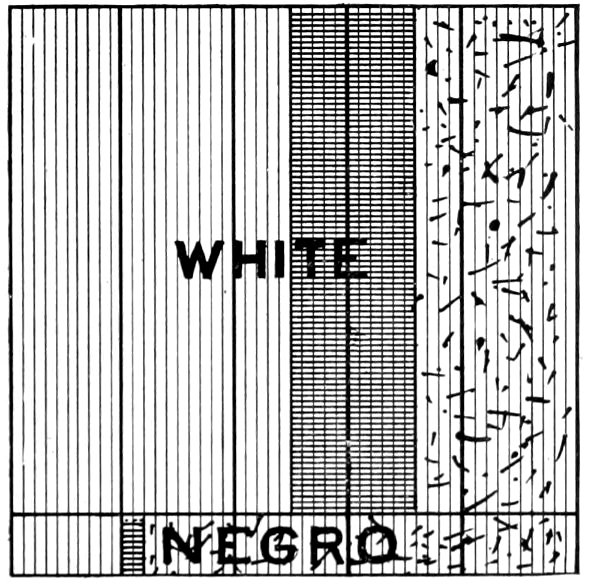
HOMES.
Diagram No. 12.